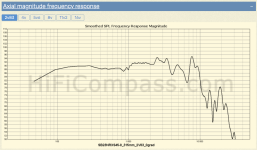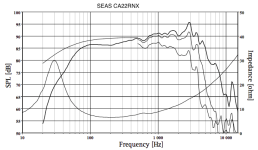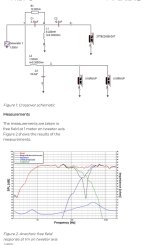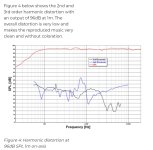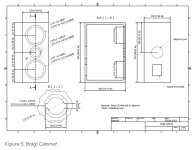SB23NRX is not "a bit better" but another class. From construction details and materials used. The W200S was a good low cost woofer 40 years ago. Today it isn't low cost anymore, but very expensive for an aged pressed steel paper cone with a small 35mm voice coil, 3.5mm linear stroke and undersized magnet. As it has been used quite often over so many years, it is more offered as a spare part than something to concider for a new build. If you could hold it in your hand, you would not even think about using it. If you read about excursion of +-10mm this is x-damage. Linear is +-3.5mm.
< SB23NRX is not "a bit better" but another class.
Thanks for that. What do I do for a crossover, though?
Thanks for that. What do I do for a crossover, though?
Try to find a well working combination with a good reputation. This may give you an idea where to start. Then measure what you get out of your cabinet and modify the crossover to taste...
The other way would be classic loudspeaker design, something you can not learn on the internet in two weeks. Like doing an impedance compensation and then calculate x-values. Measure and see how things match up, modify until everything works well.
In each case listening and measuring go hand in hand. One advice: Don't use a critical amp for designing, like a weak valve. You may develop in a complete wrong direction. Take a reverence amp, my choice would be a TPA3255, like AYIMA A07 Cheap and perfect, it doesn't care for stupid load values or a short under load.
The other way would be classic loudspeaker design, something you can not learn on the internet in two weeks. Like doing an impedance compensation and then calculate x-values. Measure and see how things match up, modify until everything works well.
In each case listening and measuring go hand in hand. One advice: Don't use a critical amp for designing, like a weak valve. You may develop in a complete wrong direction. Take a reverence amp, my choice would be a TPA3255, like AYIMA A07 Cheap and perfect, it doesn't care for stupid load values or a short under load.
Thanks for that. I have a starting point crossover which will get it up and running, see pic. After that I'll have to look at some tools for analysis. I have a good studio mic so needs some software for my mac. I think I should use my SE tube amp since that's what will be driving it.
What would you choose between SB29RDC and SB26ADC for this? The crossover was for SB29RDC but maybe the SB26ADC is a better sounding tweeter? Xover is around 1.8K to 2K.
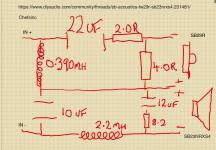
What would you choose between SB29RDC and SB26ADC for this? The crossover was for SB29RDC but maybe the SB26ADC is a better sounding tweeter? Xover is around 1.8K to 2K.

There are several comments about box volume on the thread with that particular driver
https://www.diyaudio.com/community/threads/sb-acoustics-tw29r-sb23nrxs4.231481/
So I stick a w200s into my design. At 20L I get an unacceptable bass boost at 100Hz, Switch to 30L and no significant change, Go to 50L and it's gone, F6 hasn't altered much from where I started at these volumes. As it's still using an xover of ~2.5k there is more ripple than I had with the w170s. Then phase, important in the xover region. It's way out and completely out of sync with the tweeter. Reducing the xover F should cure that with a suitable tweeter. The one i was using may not be suitable. 30Hz SPL with the 8", A bit of gain where it's xmax limited. As is being mentioned the fix is higher linear xmax, Costs rocket. This is a completer design of an 8+1. The woofer is discontinued and it looks like newer versions are getting up to ~£200, Newer versions may or may not work with the same xover.
http://www.troelsgravesen.dk/8555-7100.htm
Visaton make other 200mm drivers and prices where they gain are likely to be much the same.
The other option is use 2 at the woofer end. This may allow something smaller than a 6 1/2 to be used. Smaller mean higher F cone break up etc and less beaming, Always a but though, resonant F is likely to creep up. That also figures at the bass end but optimum box volume is likely to be smaller.
After it all comes just how accurate is the simulation. 🙂 I'd be happier about the number of £ spent if I had done one, I'd rather keep a fist one cheap.
https://www.diyaudio.com/community/threads/sb-acoustics-tw29r-sb23nrxs4.231481/
So I stick a w200s into my design. At 20L I get an unacceptable bass boost at 100Hz, Switch to 30L and no significant change, Go to 50L and it's gone, F6 hasn't altered much from where I started at these volumes. As it's still using an xover of ~2.5k there is more ripple than I had with the w170s. Then phase, important in the xover region. It's way out and completely out of sync with the tweeter. Reducing the xover F should cure that with a suitable tweeter. The one i was using may not be suitable. 30Hz SPL with the 8", A bit of gain where it's xmax limited. As is being mentioned the fix is higher linear xmax, Costs rocket. This is a completer design of an 8+1. The woofer is discontinued and it looks like newer versions are getting up to ~£200, Newer versions may or may not work with the same xover.
http://www.troelsgravesen.dk/8555-7100.htm
Visaton make other 200mm drivers and prices where they gain are likely to be much the same.
The other option is use 2 at the woofer end. This may allow something smaller than a 6 1/2 to be used. Smaller mean higher F cone break up etc and less beaming, Always a but though, resonant F is likely to creep up. That also figures at the bass end but optimum box volume is likely to be smaller.
After it all comes just how accurate is the simulation. 🙂 I'd be happier about the number of £ spent if I had done one, I'd rather keep a fist one cheap.
@andyjevans
The crossover you show is a good example why you should use a stable, short and stupid load safe amp, not your valve...
If you use the capacitor and coil in the input and change values, such a crossover may represent a tough load without you noticing.
Maybe stick to a conventionel design and leave the series crossover for later.
Also, get a setup to measure impedance values.
The crossover you show is a good example why you should use a stable, short and stupid load safe amp, not your valve...
If you use the capacitor and coil in the input and change values, such a crossover may represent a tough load without you noticing.
Maybe stick to a conventionel design and leave the series crossover for later.
Also, get a setup to measure impedance values.
I have simulated both series and parallel x-overs with the adc tw for the baffle size you posted above.
W is 130mm from bottom, T is 330mm from bottom and 40mm to the left.
The phase is better with the parallel version and you have break-up with both x-over. The amplifier load is quite easy.
The power response is not optimal because a TW with waveguide is almost mandatory with these drivers.
The LCR group on the left of the generator is for tube amp only. You can use the cdc tweeter too.
Remember that these are just simulations and real measurements could be different.
Parallel


Series


W is 130mm from bottom, T is 330mm from bottom and 40mm to the left.
The phase is better with the parallel version and you have break-up with both x-over. The amplifier load is quite easy.
The power response is not optimal because a TW with waveguide is almost mandatory with these drivers.
The LCR group on the left of the generator is for tube amp only. You can use the cdc tweeter too.
Remember that these are just simulations and real measurements could be different.
Parallel
Series
The response curve of the SB23NRX is a bit too rough in the mids for my tastes. I dont think this driver will perform as clean as some others and still require steep, lower cutoff slopes to bend into shape. That means a higher xover parts count and cost as well.
The main problem for me is the large surround to cone reflection wiggle around 1k. Thats very audible on this driver. The other irregularities can be worked around with a low and steep xover, but the tweeter won't have it easy.
Most people are ok pushing a tweeter harder with a low xover, but for my ears its too rough sounding, even if THD measurements suggest otherwise. I personally would cross a 1" dome at least 2.3 - 2.5k 2nd order, even if power response suffers a little. I guess it depends on one's priorities of the design. Using a WG definitely helps here as long as the low end sensitivity gain is there for the tweeter to reduce dome excursion.
These days it seems most people prefer the best possible power response over any other performance aspect. I understand this, but having a crossover point smack in the middle of the midrange demands much more critical design work in the xover, which becomes more expensive.
The main problem for me is the large surround to cone reflection wiggle around 1k. Thats very audible on this driver. The other irregularities can be worked around with a low and steep xover, but the tweeter won't have it easy.
Most people are ok pushing a tweeter harder with a low xover, but for my ears its too rough sounding, even if THD measurements suggest otherwise. I personally would cross a 1" dome at least 2.3 - 2.5k 2nd order, even if power response suffers a little. I guess it depends on one's priorities of the design. Using a WG definitely helps here as long as the low end sensitivity gain is there for the tweeter to reduce dome excursion.
These days it seems most people prefer the best possible power response over any other performance aspect. I understand this, but having a crossover point smack in the middle of the midrange demands much more critical design work in the xover, which becomes more expensive.
Agree with everything you said. I also do not like the combination of an 8 inch woofer in a 2 way and, besides, the simulation of higher slope filters is much more complicated and unreliable if you do not have actual measurements.
Anyway the response of the Seas U22 you suggested above is smoother and easier to cross over.
Anyway the response of the Seas U22 you suggested above is smoother and easier to cross over.
< I also do not like the combination of an 8 inch woofer in a 2 way and, besides, the simulation of higher slope filters is much more complicated and unreliable if you do not have actual measurements.
My ambition here was a sealed enclosure and that narrows down the choice of 8" speakers to units like the SB23NRX. If I let go of that ambition there are several 8" mid-bass units that are smoother and easier to work with in a 2-way. I'd like sealed if possible, though. I ordered a pair of SB26ADC so they are available. If I use a ported design a 6.5" is a fall-back option and would make things easier.
My ambition here was a sealed enclosure and that narrows down the choice of 8" speakers to units like the SB23NRX. If I let go of that ambition there are several 8" mid-bass units that are smoother and easier to work with in a 2-way. I'd like sealed if possible, though. I ordered a pair of SB26ADC so they are available. If I use a ported design a 6.5" is a fall-back option and would make things easier.
Profiguy mentioned the U models of the Prestige series by Seas. The SB23 has multiple peaks that are difficult to notch because they are in a close sequence.
As usual the FR contained in the datasheet are measured in the box and not on IEC baffle.
U18RNX/P - 6.5" in 8L box - very linear and smooth

U22REX/P-SL - 8" in 21L box

As usual the FR contained in the datasheet are measured in the box and not on IEC baffle.
U18RNX/P - 6.5" in 8L box - very linear and smooth
U22REX/P-SL - 8" in 21L box
I'm glad your mind is open to other drivers. The SB tweeter you have is a good one. You'd want at least a hard paper cone to gel with it. That means the Seas CA22 is a good option given you can get rid of most of that upper end breakup peak, which likely isn't a difficult thing to to.
You may want to look at the Seas U22 I mentioned earlier, mainly because its an easy woofer to work with in the mids, very efficient, mates well with your Alu dome SB tweeter and can be EQed for lower cutoff in a sealed enclosure. Even if you design the box for a critically dampened sealed tuning, the low end will be extended with room gain and you can do a passive line level EQ with an RC filter on the front end if DSP isn't your thing.
The U18RNX-P in an MTM is another option. Seas has their Bragi speaker kit with these woofers available along with crossover specs. They did a nice job getting the power response right with this design and I believe your tweeter in a WG would work well instead of their suggested DXT tweeter. This tweeter is good, but a little shy on the extreme top end and lacks the sparkle I prefer, which Alu/Mg domes are known for. They make up for this in the xover design with a CD EQ consisting of a small cap bypassed with a resistor (see below). You'd have to do this with a WGed tweeter anyways.
You may want to look at the Seas U22 I mentioned earlier, mainly because its an easy woofer to work with in the mids, very efficient, mates well with your Alu dome SB tweeter and can be EQed for lower cutoff in a sealed enclosure. Even if you design the box for a critically dampened sealed tuning, the low end will be extended with room gain and you can do a passive line level EQ with an RC filter on the front end if DSP isn't your thing.
The U18RNX-P in an MTM is another option. Seas has their Bragi speaker kit with these woofers available along with crossover specs. They did a nice job getting the power response right with this design and I believe your tweeter in a WG would work well instead of their suggested DXT tweeter. This tweeter is good, but a little shy on the extreme top end and lacks the sparkle I prefer, which Alu/Mg domes are known for. They make up for this in the xover design with a CD EQ consisting of a small cap bypassed with a resistor (see below). You'd have to do this with a WGed tweeter anyways.
Attachments
< I'm glad your mind is open to other drivers. The SB tweeter you have is a good one. You'd want at least a hard paper cone to gel with it. That means the Seas CA22 is a good option given you can get rid of most of that upper end breakup peak, which likely isn't a difficult thing to to.
I was looking at the SEAS Mimir, which uses the CA18NRX. The Fr looks very close to the CA22NRX and maybe this crossover would work as a starting point if I bought the CA22NRX?
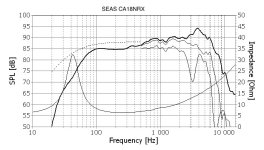
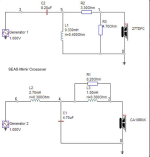
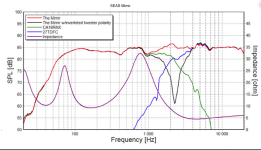
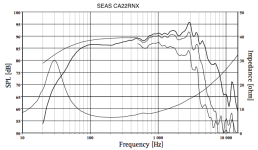
I was looking at the SEAS Mimir, which uses the CA18NRX. The Fr looks very close to the CA22NRX and maybe this crossover would work as a starting point if I bought the CA22NRX?




Using the larger driver with the same crossover layout won't likely work due to the peaks being 1k apart. The driver location on the baffle is also different, which also will throw a wrench into the existing crossover being designed for a specific anf driver baffle layout.
The peaks are in different places and the amplitude is not the same. The peak will be the biggest influence on the driver's audible characteristics. This must be dealt with, otherwise you'll have a very fatiguing speaker which isn't enjoyable to listen to. Luckily the driver only has one dominant peak, so its just a straight forward solution. Drivers with multiple or wider, asymmetric peaks can be very difficult to straighten out. This is mostly the case with undampened Alu or Mg cones and some others like kevlar sandwich, carbon fiber and textreme composites. These drivers sound good in the lower end being very rigid, but need very complex xovers to play well in the midrange. More often than not, you'll still be able to hear the breakup modes with a critical ear when playing piano and female vocals.Does the response curve of the SEAS CA22RNX look better than the SB23NRX? They're quite similar.
View attachment 1242941View attachment 1242942
Harder paper cones are usually my preferred cone material, but some plastics can sound very clean as well. Not all poly cones behave the same way, especially with different cone profiles. Just infusing them with minerals and other fibers can change their dampening characteristics as can varying the material thickness over the cone profile. Harbeth swears their poly cone material and profiles sound more natural than other materials, which I partially agree with. I used to dislike most poly cones aside from a few Dynaudio, ScanSpeak and Seas drivers, but having owned my first set of Harbeth monitors changed my opinion. They of course use complex xovers, which causes its own set of issues if not carefully designed.
The LCR notch needed to reduce the main breakup peak in the mids is fairly simple to calculate based on the manufacturer data and fine tune with experienced ears using pink noise. Measurements sure help and are the preferred way of doing things, but a good ear can do it as well. I catch alot of friction from some people on here saying this, but I wouldn't suggest it if it wasn't easily achievable. Its pretty easy to hear FR anomalies. You can even use EQ to isolate it as well, then translate the EQ into the LCR needed to flatten the response.
Last edited:
Thanks profiguy. So the CA22RNX with a crossover around 2K looks achievable. Looks like a good mid-bass and it's inside my budget (just about). You're suggesting it's a better choice than the SB23NRX.....
Yes, the CA22RNX is absolutely more suitable for a 2 way design than the SB23NRX. This driver has been around for a while in various other incarnations, but its still a very good driver by today's standards. Troels used it in the Poor Man's Strad, which is a very nice sounding speaker in many regards. Being a 3 way design, it doesn't run the woofer nearly as high, but the bass quality is very natural and extended, which is the typical behavior for many Seas paper cones. I've built monitors using CA22RNX, mainly as 3 way designs using dome mids, but if you tread carefully, this woofer can sound very good in a 2 way to just above 2k with a very capable dome tweeter.
I strongly suggest a large WG to keep dispersion consistent around the xover area if crossing around 2k. The lower you cross, the bigger the WG needs to be. Fortunately there are existing designs from Augerpro using your SB tweeter. You may want to consult with him on your specific application and throw him some funds for his hard work. He's done all these WG designs for free.
These Seas paper cones may not be the lowest distortion drivers, but they sound a bit better in practically than most other dated paper cone driver designs. Don't get hung up too much in a ton of measurement data trying to decide on a driver. Unless you really know what matters most regarding THD measurements, the analysis paralysis will drive you crazy if you're OCD about these things.
I strongly suggest a large WG to keep dispersion consistent around the xover area if crossing around 2k. The lower you cross, the bigger the WG needs to be. Fortunately there are existing designs from Augerpro using your SB tweeter. You may want to consult with him on your specific application and throw him some funds for his hard work. He's done all these WG designs for free.
These Seas paper cones may not be the lowest distortion drivers, but they sound a bit better in practically than most other dated paper cone driver designs. Don't get hung up too much in a ton of measurement data trying to decide on a driver. Unless you really know what matters most regarding THD measurements, the analysis paralysis will drive you crazy if you're OCD about these things.
Looks like I may go ahead with the CA22RNX then. I can add a waveguide later when i have it up and running. The front is going to be removable so I can try out different arrangements. The good thing is I can use the CA22RNX in a sealed 25litre box and get a F3 of 53Hz which will be OK for my needs. Fulfils the goal I had in mind. Thanks for your contributions. Appreciated, as with everyone else who has replied.
Thanks from me too. I do have a query on these SEAS graphs - where are they. Seems that they are available for different box sizes. Also what is the significance of the dotted line at the bass end - what is it in other terms.
I've followed 101 on chassis selection. Crossover in a place to avoid the peaks. These SEAS appear to need corrections. This tempts me to look at one or two Dayton chassis so will.
😉 I wondered about starting my own thread concerning Xmax queries but there are lots of these and no clear answers really. Some even say measure it when distortion is a concern. Part of the reason for wondering is a Visaton part. They spec one for 10% distortion in the data sheet, a recognised standard yet load 3mm when the driver is loaded using their data included in Boxsim. LOL a bit of a black hole between to 2 figures but more info.
I've followed 101 on chassis selection. Crossover in a place to avoid the peaks. These SEAS appear to need corrections. This tempts me to look at one or two Dayton chassis so will.
😉 I wondered about starting my own thread concerning Xmax queries but there are lots of these and no clear answers really. Some even say measure it when distortion is a concern. Part of the reason for wondering is a Visaton part. They spec one for 10% distortion in the data sheet, a recognised standard yet load 3mm when the driver is loaded using their data included in Boxsim. LOL a bit of a black hole between to 2 figures but more info.
- Home
- Loudspeakers
- Multi-Way
- Which 6.5" mid-bass for a sealed box?
